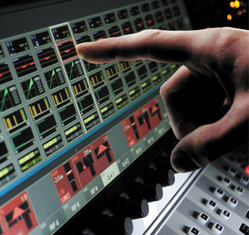Do you remember how you were taught to use EQ? Were you really taught, or did you just figure it out?
One of the questions that I get asked all the time is how I know what to adjust on the EQ section of the console. I’ve found that if you can make it into a numbers game, turning the right knob becomes second nature.
When I teach sound, one of the things that we spend a lot of time on is frequency response. That’s because for me, when frequency response was explained the light bulb came on. All of the sudden things made sense and I could quantify what I was hearing.
Once I explain frequency (you know the drill—hearing is 20 Hz to 20 kHz or 20,000 Hz, low to high), the lesson continues by giving anchor points. I start by drawing a horizontal line, putting 20 Hz on the left side and 20 kHz on the right side of the line.
Then I began talking about a kick drum normally being tuned in the 80 Hz to 100 Hz range and draw a vertical line just to the right of the 20 Hz mark. This is anchor point #1.
I then ask what a piano is tuned to, and every time someone in the audience will throw out A440. Bingo, 440 Hz. If a piano is available, I then hit the A440 key (the A above middle C) on the piano, or if a piano isn’t available I use a pitch pipe.
I then draw a vertical line to the right of 80 HZ that is approximately one-third of the way up the horizontal line. This is anchor point #2.
Unfortunately, the next illustration is becoming less and less applicable as it’s no longer used very often. If you’re over the age of 35, you probably remember the tone generated by the Emergency Broadcast System (EBS). It’s not as commonly heard these days, so for those too young to have heard or remember, it was a 1,000 Hz (or 1 kHz) tone that played on radio and television stations, accompanied by an announcer saying, “This is a test of the Emergency Broadcast System, this is only a test…” (Check it out here.)
Regardless, I still use it in training, doing my best to replicate the 1,000 Hz tone vocally by saying “DOOOOOOOOOOOOOOOO” and trying to hold the pitch on or at 1 kHz. (Those who have been to one of my training sessions know that this is a weak point…:>)
For the younger crowd, and to the delight of those who may someday be in one of my training classes, I downloaded a frequency generator app to my phone. While my phone’s speaker won’t reproduce much below 150 Hz, I’m able to clearly play A440 and the EBS tone.
Anyway, back to the lesson. After hearing the EBS tone, I then draw a vertical line to the right of 440 Hz that is approximately half of the way up the horizontal line. Anchor point #3.
I then will selectively put the sound system that I’m using into feedback by boosting frequencies on an open mic channel. When the feedback starts, I ask if it’s above or below 80 Hz? Above? OK, then is it above or below 440 Hz? Above? OK, then is it above or below 1 kHz? Below? OK, our feedback issue is between 440 Hz and 1 kHz. Now, it it closer to 440 Hz or 1 kHz?
You get the point. Now they’re getting an understanding of where to adjust the EQ.
I then move the frequency knob between 440 Hz and 1 kHz, and then cut the level at and around the frequency the sweep knob is on. I can then also move the sweep knob up and down until I hit the frequency that best solves my feedback problem.
The goal is for this numbers game to translate to greater understanding of EQ. It can be taken further if needed, but usually, what I’ve described here unlocks the mystery for most fledgling audio techs.
Gary Zandstra is a professional AV systems integrator with Parkway Electric and has been involved with sound at his church for more than 30 years.


















